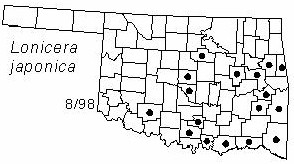Trailing and twining woody vine with branches often several m long. Stems pubescent when young, becoming reddish-brown with bark sometimes shredding, often producing adventitious roots at the nodes. Leaves opposite, somewhat leathery, semi-evergreen, never perfoliate, ovate to oblong, 3-8 cm (1.2-3.1 in) long and 1.5-3 cm (0.6-1.2 in) wide, margins entire, apex acute to obtuse, base cuneate, rounded or truncate, petiole about 1 cm (0.4 in) long and pubescent. Flowers in pairs terminating axillary peduncles having foliaceous bracts. Corolla bilaterally symmetrical, 2-4 cm (0.8-1.6 in) long, white, pale yellow, or pink.
Distribution: The species is native to eastern Asia, but has become naturalized over most of the eastern U. S.
Habitat: Roadsides, abandoned fields, old homesites, forest margins.
NWI status: FAC
Comment: Japanese honeysuckle is probably more abundant in Oklahoma than the map below (which represents herbarium specimens) would indicate. Lonicera honors the German herbalist Adam Lonitzer; japonica refers to Japan, where it was discovered.
Distribution in Oklahoma: 
BACK
NEXT
RETURN TO INDEX
Last update: 9/14/99
 Go to Oklahoma Biological Survey Home Page
Go to Oklahoma Biological Survey Home Page
 Disclaimer
Disclaimer